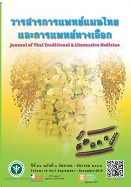Effect of Temperature and Duration of Tea Infusing Process on Total Phenolics Content and Anti-Oxidant activity in Clitoria ternatea L. Flower Tea
Main Article Content
Abstract
Clitoria ternatea L. is a herb that has antioxidant activity. It also stimulates blood circulation to the eyes which help to the nourish eyes and is good for hair growth. Thus, the development of herbal tea from it is an interesting alternative product for health care. This research aims to evaluate the optimal time and temperatures conditions for tea infusions from Clitoria ternatea L. flower. These tea were prepared by soaking in hot water for various time (5, 10 and 15 minutes) and temperature (60, 80 and 100°C). The total phenolics content (TPC) and antioxidant activity of them were investigated via using Folin-Ciocalteu and DPPH (1,1-diphenyl-2-picrylhydrazyl) radical scavenging activity assay, respectively. The results demonstrated that the time and temperature of tea infusions effect TPC and antioxidant activity with significant differences (p < 0.05). At time of 10 minutes and a temperature of 80°C, the tea showed the highest amount of TPC and % DPPH radical scavenging activity, with 47.56 ± 1.36 mg GAE/g and 31.19 ± 1.27%, respectively. It can be concluded that the optimal infusion for Clitoria ternatea L. flower was at 80°C for 10 minutes.
Article Details
References
2. Kazuma K, Noda N, Suzuki M. Flavonoid composition related to petal color in different lines of Clitoria ternatea. Phytochemistry. 2003;64(6):1133-9.
3. Mukherjee PK, Kumar V, Houghton PJ, et al. Screening of Indian medicinal plants for acetyl cholinesterase inhibitory activity. Phytother Res. 2007;21:1142-5.
4. Kumar N, Rungseevijitprapa W, Narkkhong N-A, Suttajit M, Chaiyasut C. 5α-reductase inhibition and hair growth promotion of some Thai plants traditionally used for hair treatment. Journal of Ethnopharmacology. 2012;139(3):765-1.
5. Wongsuriyasak S, Chotinan S. Development of herbal drink from butterfly pea flowers (Clitoria ternatea L.) for Commercialization. Chiang Mai: Chiang Mai University; 2018. (in Thai)
6. Jamil N, Zairi MNM, Nasim NAM, Paûee F. Influences of environmental conditions to phytoconstituents in Clitoria ternatea (butterfly pea flower) - A review. Journal of Science and Technology. 2018;10(2):208-28.
7. Sukkhamduang W, Porasuphatana S, Priprem A. Alternative: Substances from butterfly pea: chemical composition and action. Bureau of academic service journal, KKU. 2009;17(4):10-5. (in Thai)
8. Valko M, Leibfritz D, Moncol J, Cronin MT, Mazur M, Telser J. Free radicals and antioxidants in normal physiological functions and human disease. Int J Biochem Cell Biol. 2007;39:44-84.
9. Sinthupibulyakit C. The antioxidant activities in infusions and ready-to-drink herbal teas. Academic Meeting National and International Conference, SSRU. 2015;1(6):165-72. (in Thai)
10. Noosing S, Mundee P, Leelawat B. Development of instant germinated purple rice tea. Thai Journal of Science and Technology, TU. 2014;22(3):337- 46. (in Thai)
11. Vernon LS, Orthofer R, Lamuela-Ravent_s RM. Analysis of total phenols and other oxidation substrates and antioxidants by means of folin-ciocalteu reagent. Methods in Enzymology. 1999;(299):152-78.
12. Bondet V, Brand-Williams W, Berset C. Kinetics and mechanisms of antioxidant activity using the DPPH. free radical method. LWT - Food Science and Technology. 1997;30(6):609-15.
13. Ruksounjik O, Khunkitti W. The comparative study in bioactivities of Rang jeud, Butterfly pea and red grape peel. Isan Journal of Pharmaceutical Sciences. 2016;12(1):61-9. (in Thai)
14. Niamsa N. Chitosan microparticles for use as controlled release drug delivery systems. Burapha Science Journal. 2013;18(2):281-7. (in Thai)
15. Shoaib MH, Tazeen J, Merchant HA, Yousuf RI. Evaluation of drug release kinetics from ibuprofen matrix
tablets using HPMC. Pak J Pharm Sci. 2006;19(2):119-24.
16. Luemchan D, Chantrapornchai W, Haruthaithanasan V. Extraction of anthocyanin from black glutinous rice (Oryza sativa L.). Proceedings of 46th Kasetsart University Annual Conference: Agro-Industry, KU, BKK. 2008:320-7. (in Thai)
17. Ekici L, Simsek Z, Ozturk I, Sagdic O, Yetim H. Effects of temperature, time, and pH on the stability of anthocyanin extracts: Prediction of total anthocyanin content using nonlinear models. Food Anal Methods. 2014;7(6):1328-36.
18. Rabeta MS, An Nabil Z. Total phenolic compounds and scavenging activity in Clitoria ternatea and Vitex negundo Linn. International Food Research Journal. 2013;20(1):495-500.
19. Kamkaen N, Wilkinson JM. The antioxidant activity of Clitoria ternatea flower petal extracts and eye gel. Phytotherapy Research. 2009;23(11):1624-5.


